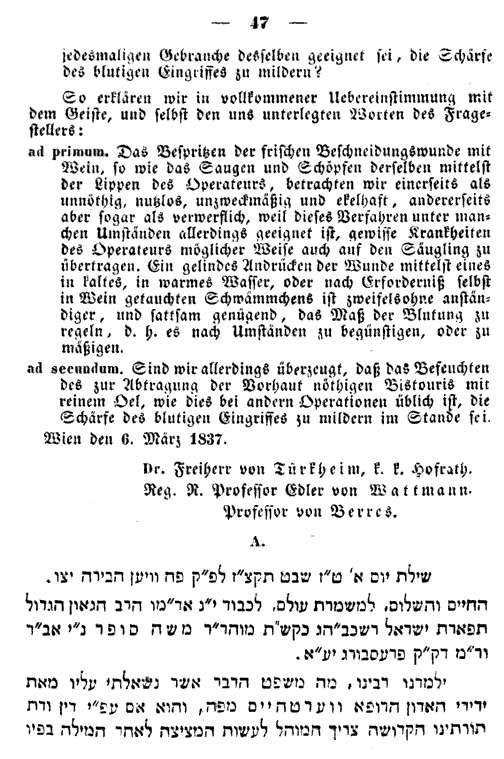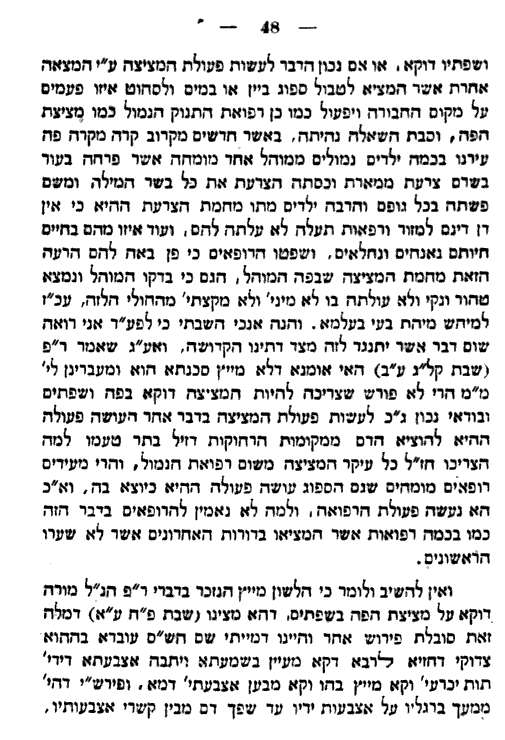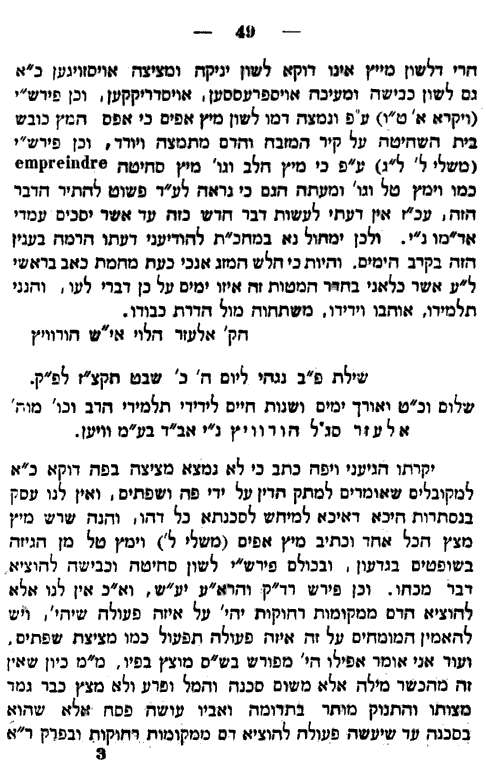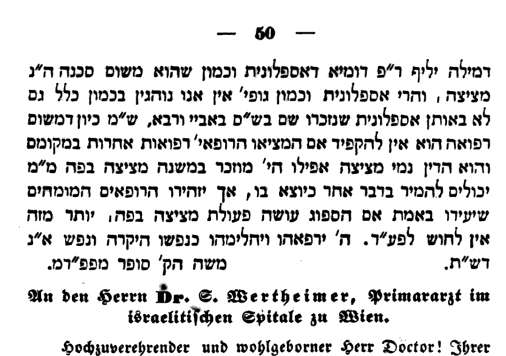Metzitzah be-feh has been in the news lately, as it will be every few years. I thought it might be nice to translate two important documents relating to this controversy since, to my surprise, I discovered that neither seems to have ever been translated and published in its entirety. I mean the question which R. Elazar Horowitz of Vienna sent to his teacher the Chasam Sofer in 1837, and the response he received. I once posted the letters as they were printed in the first volume of Kochve Yitzchak (1845) (link). Here are the letters and the translation:




I have of course taken some liberties. Obviously Rabbi Horowitz's letter did not begin "Dear Rabbi Sofer," but I didn't want all the titles, which aren't meant to be translated, to be distracting. On the other hand I also didn't want to completely remove the flavor of rabbinic writing, so I kept some of it in. But the main purpose is simply to make these documents accessible.
Sheviti, etc. Sunday 16 Shevat 5597 (1837) ViennaDear Rabbi Sofer,Teach me, Rabbi, what is the rule regarding a question which my local friend Dr. Wertheim asked of me. According to the law of our religion is a mohel required to make that suction which is performed after the circumcision specifically with his mouth? Or perhaps it is proper to peform the suction through some other means, such as to soak a sponge in wine or water and squeeze the place of the wound with it a number of times, and through this achieve the healing effect for the infant no differently than through oral suctioning? The circumstances behind this question is that some months ago in our city many children who were circumcized by a certain expert mohel developed festering sores all over the genitals and from there it spread to the entire body. Many infants died because of this, and were unresponsive to any medical attention. Some of them lived, but were in great pain. The doctors judged that this condition was caused by the mohel's orally suctioning the wound (ha-metzitzah she-be-feh). The mohel was examined and proved to have a clean bill of health, and they could not diagnose anything like this illness in him. However, we need to know what to do in a situation like this in general. Now, I answered that in my opinion I see nothing in this suggestion which is opposed by our holy Torah. Even though Rav Pappa said (Shabbat 133b) "a circumcizer who does not suction is dangerous, and we dismiss him" nevertheless it is not explicit that the suction must be specifically with the mouth and lips, and so certainly it is alright to also do it in some other manner, so as to draw blood from the 'far places.' See what is the reason why Hazal required suction: for the healing of the circumcision. Qualified physicians attest that a sponge or something like it also does this. If so, these accomplish the purpose of healing. So why shouldn't we believe the physicians in this in the same way that we accept the many medical accomplishments and advances in recent generations, which were unknown in earlier times?Do not reply that the expression מייץ mentioned by Rav Pappa refers only to oral suction, since we find in Shabbat 88a that the word has an expansive definition, for we find the very term in the case where "There was a certain Sadducee who saw Raba engrossed in his studies while the finger[s] of his hand were under his feet, and he ground them down, so that his fingers spurted blood." (See here.) Rashi there explains that he was pressing his fingers with his foot, and this is what drew blood from the fingers. Thus we see that מייץ refers to pressure and not only suction (he gives some similar examples in German). Also Rashi explains (Lev. 1:15) the words "its blood shall be drained out" that it is like the term mitz apayim "wringing of the nose" (Prov. 30) and "afes ha-metz" "the wringing out is at an end" (Is. 16) and "He presses the place of slaughtering against the side of the altar" ve-hadam mitmatzeh ve-yored, "the blood is wrung out and goes down" (Zevachim 65). Also Rashi explains the same verse in Prov. 33:3 mitz chalav "churning of milk" mitz skhitah "squeezing" (and he uses the Old French term empreindre, which means to press or stamp). From all this it seems to me clear and simple to permit it. However, with all this, I don't want to authorize something new like this until you my master concurs with me. So please pardon me, respecting your honor's Torah, to let me know your exalted opinion on these things. I have not been feeling well lately, so please send me your words.Your student and beloved friend, I bow toward your honor and glory.Ha-kattan Elazar Ha-levi Ish Horovitz
The Chasam Sofer replied as follows:
Sheviti, etc. Pressburg, Monday, 20 Shevat 5597 (1837)Greetings and long life to my student and friend Rabbi Elazar Halevi Segal Horowitz, Chief Rabbi of Vienna.Your nice letter reached me, and it is correct what you wrote, that we do not find the metzitzah (suction) is specifically with the mouth, save for the position of the Kabbalists who say that [the process] enacts a neutralization of strict judgment through the lips and the mouth. We are not engaged in mysteries when there is some concern for physical danger. Now, the roots mitz and matzat are the same, c.f., Proverbs 30[:31] mitz apayim and Judges 6:38 "and wrung dew out of the fleece." In all these places Rashi explains them in terms of squeezing, compressing, and suctioning something with force. Radak and Ibn Ezra similarly explain them. If so, we only need to draw the blood from the 'far places' though whichever method we are able, and we can rely on experts who assure us that some method accomplishes it. I further say that even if it was explicit in the Talmud that the suction is meant to be oral, nevertheless since this is not an integral part of the circumcision, but only adjoined because of a health measure, so if one circumcised and did not suction the blood, he has already performed the commandment, and the baby is permitted to eat terumah, and the father may make a Passover sacrifice. However he is in physical danger so long as the blood was not suctioned from the far places. In Chapter Rabbi Eliezer De-mila we find that Rav Pappa understood that suction is similar to the dressing and cumin, which are health measures. Now, we do not presently use the [particular] dressing [specified in the Talmud] and cumin, nor the particular type of dressing mentioned in the Talmud by Abbaye and Rava. Therefore we know that since these are for healing, we are not particular about which remedy we use in its place, and the same thing applies to suction - even if oral suction had been mentioned in the Mishnah, we would be able to change it to another method which accomplishes the same thing, so long as we heed qualifies physicians who will attest that in truth a sponge accomplishes the same thing as oral suction. More than this we needn't be concerned with, in my opinion. God should heal you and make you feel good!Moshe ha-kattan Sofer mi-Frankfurt di-Main
For a listing of some people and places were doubts about the authenticity of this exchange see Shlomo Sprecher's article Mezizah be-Peh - Therapeutic Touch or Hippocratic Vestige? in Hakirah 3. He, like me, does not find such charges convincing, although whether anyone likes it or not they have to be grappled with - as Sprecher did - in contemporary debate. Maybe in the future I will translate some of the documents relating to that charge.
I want to conclude with a quote from Buxtorf's Synagoga Judaica (The Jewish Synagogue). This 17th century book was and is considered hostile to Judaism, and properly so, but it is also highly interesting. It is believed that R. Yehuda Aryeh Modena's book describing Judaism, his Historia de' riti hebraici, was written partially as a response to Buxtorf's book. So I will quote what Buxtorf writes (from an English translation of 1657) :
. . . he cuts away so much of the fore-skin that the top of the yard may be seen bare and naked, which he throws in haste into the Bason filled with sand, restoring the knife to him from which he took it, and takes on the Cips full of red Wine, out of which he sucks so much as he can hold in his mouth, which he presently spnes out again upon the Infant to wash away the blood, and also some in his face, if he perceive him to faint: instantly upon this he takes the childs yard in his mouth, and sucks as much bloud out of if as he can possible, to the end that it may sooner leave bleeding, which bloud he casts out again, either into one of the bowls of red Wine, or into the bason of Sand. this he doth three times at the least, which the Hebrews call mezizah, which Moses Commanded not, but was instituted by the Rabbines and wise men amont the Jews, as it seemed good unto them.
Similarly, Modena writes (this is from an English translation of 1650) nothing more than
the Circumciser going on in his businesse, with his mouth sucketh the Blood, which abundantly floweth from the wound, doing thus two or three times, and so spitteth it forth in a Bowl of wine.
I believe it is important to not forget the therapeutic intention behind MBP, no matter where one falls on the spectrum of opposition. This was still clear in the 17th century, when a hostile writer could think of nothing worse to say about it than that "Moses Commanded [it] not" and the apologist who wanted to portray Judaism in its most positive light left out of his book the belief in gigulgim, but not a description of MBP - in fact, he did not even see the need to explain that this was meant for the health of the baby.
Finally, it is also interesting to note that the Chasam Sofer's permission to use a sponge relies on the attestations of physicians that it accomplishes the same healing as oral suction. I wonder if this leaves a conundrum since according to modern medicine suctioning blood from a sterile wound accomplishes nothing at all.





"Metzitzah be-feh has been in the news lately, as it will be every few years."
ReplyDeleteThat's a bit too flip of a way to describe the deaths of babies.
I just note (from memory) that some MSS of the sugya in Shabbath read אייץ or עייץ there, rather than מייץ.
ReplyDeleteYasher koach, S., for posting both the she'eila of Rav Horowitz and the teshuva of the Chatam Sofer. The equivalence of the cases they dealt with and the current and recent ones is striking. There should be no question that the Chatam Sofer would rule that metzitza b'feh (MbP) is a sakana and, therefore, assur min hadin - despite any supposed kabbalistic benefit. I note that a vascular surgeon/mohel, Dr. Gelbfish, has a well reasoned article cited in Vosizneias which attacks the minority (or unique) medical view of Dr. Berman on whom the defenders of MbP appear to rely.
ReplyDelete(from Wikipedia here:
ReplyDeletehttp://en.wikipedia.org/wiki/Brith_milah#Suction.2C_metzitzah_technique)
Moses Sofer (1762–1839) observed that the Talmud states that the rationale for this part of the ritual was hygienic — i.e., to protect the health of the child.
The Chasam Sofer contended that metzitzah with a sponge would accomplish the same purpose as oral suction. His letter was published in Kochvei Yitzchok.
Moshe Shik (1807–1879) a student of Moses Sofer, states in his book of Responsa, She’eilos u’teshuvos Maharam Shik (Orach Chaim 152,)that Moses Sofer gave the ruling in that specific instance only and that it may not be applied elsewhere.
He also states (Yoreh Deah 244) that the practice is possibly a Sinaitic tradition, i.e., Halacha l'Moshe m'Sinai.
Chaim Hezekiah Medini, claimed the practice to be Halacha l'Moshe m'Sinai and elaborates on what prompted Moses Sofer to give the above ruling:
He tells the story that a student of Moses Sofer, Lazar Horowitz, author of Yad Elazer and Chief Rabbi of Vienna at the time, needed the ruling because of a governmental attempt to ban circumcision completely if it included metztitzah b'peh.
He therefore asked Sofer to give him permission to do brit milah without metzitzah b’peh.
When he presented the defense in court, they erroneously recorded his testimony to mean that Sofer stated it as a general ruling.
WADR to the Maharam Shick, we have the words in front of us. It wasn't RLH's presentation of the CS's position that omits the limitations on his heter -- they simply aren't there, and don't fit the CS's line of reasoning.
ReplyDeleteOdds are the MS was shocked by rumors, couldn't "be meqabel" that his rebbe would say such a thing. He obviously never saw the teshuvah.
I have to agree with Micha. I always find it deeply disturbing that when presented with an authentic, argumented teshuva grounded in sound Talmudic and Halachic logic that happens to go against the political consensus of one group or another, you always have someone who will say "he didn't really mean that, he was just concealing the truth mi-shum eiva or for fear of censorship". If it is so, that an argumented teshuva can be refuted on political grounds, then why should we trust any teshuva, or indeed anything?
ReplyDeleteI should point out that originally in the post I noted three additional places where this teshuva was printed, and the reason why is because Dr. Sprecher, in his article, seemed to have written that it was only printed this one time, in Kochve Yitzchak. I though that as a bibliographical matter I should point out the other places. Then I realized that I misunderstood him. The first two of the three which I pointed out were both printed around 1900. That meant that it was printed only one time in all of the 19th century - in 1845, and in this one periodical. This meant that many, if not most, of the rabbis who discussed his teshuva throughout all of the 19th century had not read the teshuva, but were discussing a reported teshuva. This made it possible for people to speculate or even fudge that he was talking about a particular case and a particular mohel. But if you read the teshuva you can see that these things are simply not true. As for the historical circumstances which the Sdei Chemed reports/relates/claims/assumes, they also do not fit in with the facts. I'm not saying that he made it up; possibly or even probably this is what he had heard. But it isn't true.
ReplyDeleteI should also point out that Jacob Katz in his article about the controversy over metzitzah notes that when this teshuva was written, in 1837, there had not yet been agitation among Reformers against bris milah and contrary to what is claimed here, all governments *required all Jews to be circumcised* and no one was banning circumcision (even if there were of course medical opinions and some popular revulsion against it). I recently posted about what was a chiddush, a few years later (1843), when the government in Frankfurt for the first time allowed the possibility of Jews making the decision not to circumcise their children. Remember, back then you had to be a registered Christian or Jew, no exceptions, and the governments knew and recognized that to be a Jew meant that you had to be circumcised.
So Jacob Katz theorized that had the Chasam Sofer known that less than 10 years later even this assumption was going to be called into question by the Reformers which, contrary to popular belief, was not obviously going to happen at all, and the proof is that by and large Reform Judaism rejected the rejection of circumcision until this very day - had he known it, he would have ruled strictly here. But he didn't know it, and he did not rule strictly. So I say what we see here is the unguarded Chasam Sofer, just being horeh the halacha. No public policy - a truthful analysis of the straight halacha and the nature of metzitzah. It's medical, any means suffices, we can trust the doctors, and we are not concerned with kabbalah when health is on the line.
Now, I realize that Maharam Schick is a weighty authority.
So was the Chasam Sofer.
They could ay that he never wrote it. It's not in his handwriting.
ReplyDeleteThey could say anything, can't they?
ReplyDeleteAnd it is in his handwriting. The teshuva, in his hand, (reportedly) exists. It has "horaah shaah" handwritten by someone else on the side.
Who made R. Horowitz "chief rabbi of Vienna?"
ReplyDeleteThe same as any "chief rabbi." He was the av beis din of Vienna. I'm not sure what the exact process was at the time, but same as anywhere else, Jewish communities were officially recognized by governments and there was a recognized chief rabbi. The same thing which made the Chasam Sofer "chief rabbi of Pressburg" made R. Lazar Horowitz "chief rabbi of Vienna." Appointment by parnasim and approval by the government.
ReplyDeleteTotally unrelated- just curious if anyone knows anything about this; In the preface to the book "Kithvei Arukh haShulkhan" Rabbi Y.A. Horowitz writes that "after consultation with gedolim it was decided not to omit any writings of the Arukh haShulkhan that I was aware of". It is quite obvious that he is referring to a responsa printed there, where Aruha"sh permits MB"P.
ReplyDeleteWhat is interesting though is that he doesn't note that in Aruha"sh (Y.D. 264, 19) Meziza biKeli is explicitly prohibited...
That the suction of blood is pointless after a sterile operation which mohels who are doctors provide is a useful hint about the pointlessnes of the whole ritual. Rituals are pointless acts. Real reasonable acts do not need a ritualistic setting.
ReplyDeleteOf course it's pointless. There's no medical reason to perform metzitzah, or circumcision for that matter. Rituals are an entirely different matter; you can take them or leave them, but no one ever said reason comes into it.
ReplyDeleteYour assertion is false. A sterile operation, will exsanguinate blood to prevent hematoma formation which delays healing or worse, in a baby, can have destructive consequences. It makes medical sense indeed to suction a circumcision site indeed.
ReplyDeleteLet me specify that we who actually perform 'surgeries' do indeed exsanguinate blood, every time we do surgery. Your assertion is false. Period
ReplyDelete